Welcome to A.S. Roma
a professional Italian football club based in Rome
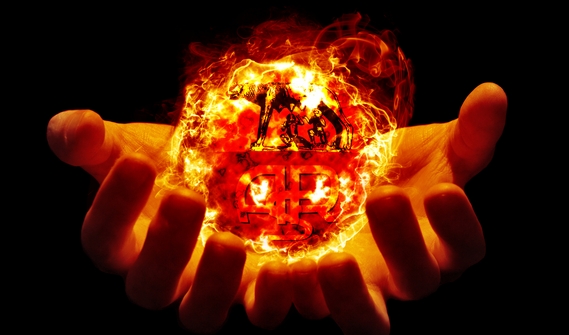
a professional Italian football club based in Rome

Associazione Sportiva Roma , commonly referred to as simply Roma , is a professional Italian football club based in Rome. Founded by a merger in 1927, Roma have participated in the top-tier of Italian football for all of their existence except for 1951–52.
Roma have won Serie A three times, in 1941–42, 1982–83 and 2000–01, as well as winning nine Coppa Italia titles and two Supercoppa Italiana titles. In European competitions, Roma won the Inter-Cities Fairs Cup in 1960–61 and were runners-up in the 1983–84 European Cup and the 1990–91 UEFA Cup.
Since 1953, Roma have played their home matches at the Stadio Olimpico, a venue they share with city rivals Lazio. With a capacity of over 72,000, it is the second-largest of its kind in Italy, with only the San Siro able to seat more. The club plan to move to a new stadium, though this is yet to start construction.
The club's home colours are Tyrian purple and gold, which gives Roma their nickname "I Giallorossi" ("The Yellow and Reds"). Their club badge features a she-wolf, an allusion to the founding myth of Rome.
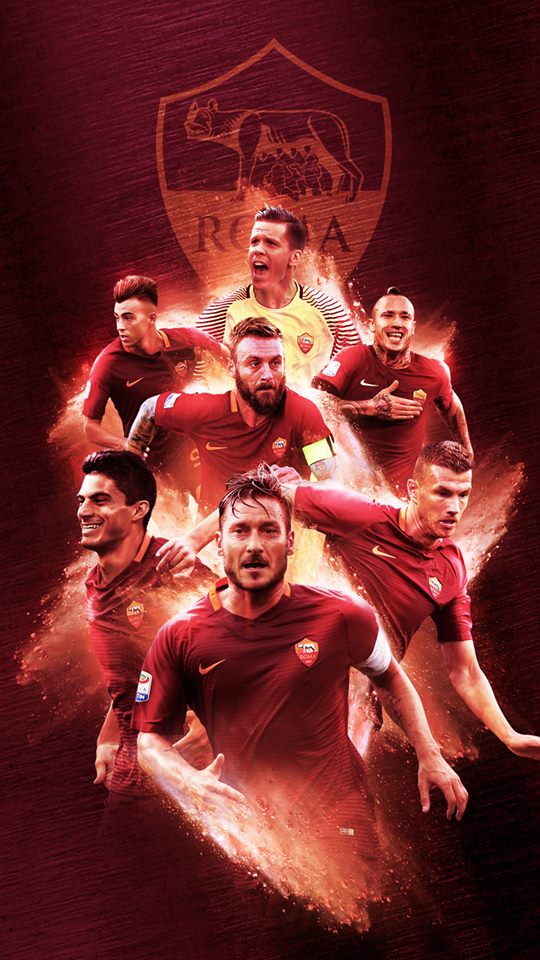
Francesco Totti holds Roma's official appearance record, having made 785 (as of 20 May 2017) appearances in all competitions, over the course of 25 seasons from 1993 until 2017.He also holds the record for Serie A appearances with 618, as he passed Giacomo Losi on 1 March 2008 during a home match against Parma.
Including all competitions, Totti is the all-time leading goalscorer for Roma with 307 goals since joining the club, 250 of which were scored in Serie A (another Roma record). Roberto Pruzzo, who was the all-time topscorer since 1988, comes in second in all competitions with 138. In 1930–31, Rodolfo Volk scored 29 goals in Serie A over the course of a single season. Not only was Volk the league's top scorer that year, he also set a Roma record for most goals scored in a season which would later be matched by Edin Džeko in 2016–17.
Its major founders Fortitudo and Alba having been relegated at the end of 1926–27 campaign, new-founded Roma had to take part to Southern First Division championship (Serie B) for its inaugural season. Nevertheless, the FIGC decided on a special enlargement of first level division re-admitting AS Roma and SSC Napoli. The first ever official matches participated in by Roma was in the National Division, the predecessor of Serie A, of 1927–28, against Livorno, a 2–0 Roma win.The biggest ever victory recorded by Roma was 9–0 against Cremonese during the 1929–30 Serie A season. The heaviest defeat Roma have ever suffered is 7–1, which has occurred three times: against Juventus in 1931–32, Torino in 1947–48 and Manchester United in 2006–07.
On 7 October 2012, the Hall of Fame of Roma was announced. The Hall of Fame players were voted via the club's official website and a special Hall of Fame panel. In 2013 four players were voted in. In 2014, the third year of AS Roma Hall of Fame four more players were voted in.
Totti's incredible career in 10 iconic numbers
The very first sport facility Roma used was the Motovelodromo Appio, previously used by Alba-Audace. Roma only played the 1927–28 season there until they moved to Campo Testaccio the very next season. Campo Testaccio was used through 1929 to 1940. The team moved later to the Stadio Nazionale del PNF, where they spent 13 years before moving once again.
In the 1953–54 season, Roma moved to the Olympic arena, Stadio Olimpico, which it shares with Lazio. The arena has undergone several changes over the years. The most significant change took place in the nineties when Stadio Olimpico was demolished and then reconstructed to for the 1990 FIFA World Cup, held in Italy. Roma have played almost every season since 1953–54, with exception of the 1989–90 seasons due to the reconstruction of Stadio Olimpico. That year, Roma played its home matches at Stadio Flaminio.
On 30 December 2012, Roma club president James Pallotta announced the construction of a new stadium in the Tor di Valle area of Rome. The new stadium, Stadio della Roma, will have a capacity of 52,500 spectators.On 2 February 2017, the Region of Lazio and the mayor of Rome rejected the proposal to build a new stadium. However, it was later approved on 24 February after final review of the stadium's design adjustments. In August 2017, the stadium suffered another delay, forcing Roma to renew their lease with the Stadio Olimpico until 2020. It is presently uncertain when the stadium will open.
List of stadiums used by the club
1927–1928 Motovelodromo Appio
1929–1940 Campo Testaccio
1940–1953 Stadio Nazionale del PNF
1953– Stadio Olimpico (1989–1990 Stadio Flaminio due to renovations on Olimpico)
A sports centre located in Trigoria at kilometre 3600 in south-east of Rome was purchased on 22 July 1977 by then club president Gaetano Anzalone. It was opened on 23 July 1979 as Anzalone's final act as president. The complex had its first expansion in 1984 when the club was handled by Dino Viola and another in 1998 under the chairmanship of Franco Sensi.The centre's official name is the Fulvio Bernardini di Trigoria, named after club icon Fulvio Bernardini. The centre is also known for hosting the Argentina national team during the 1990 FIFA World Cup, held in Italy.
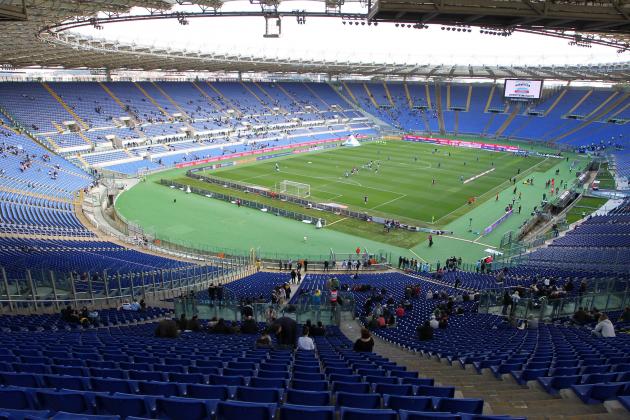
A.S. Roma was founded in the summer of 1927 when Italo Foschi initiated the merger of three older Italian Football Championship clubs from the city of Rome: Roman FC, SS Alba-Audace and Fortitudo-Pro Roma SGS. The purpose of the merger was to give the Italian capital a strong club to rival that of the more dominant Northern Italian clubs of the time. The only major Roman club to resist the merger was Lazio because of the intervention of the army General Vaccaro, a member of the club and executive of Italian Football Federation. The club played its earliest seasons at the Motovelodromo Appio stadium, before settling in the working-class streets of Testaccio, where it built an all-wooden ground Campo Testaccio; this was opened in November 1929. An early season in which Roma made a large mark was the 1930–31 championship, where the club finished as runners-up behind Juventus. Captain Attilio Ferraris, along with Guido Masetti, Fulvio Bernardini and Rodolfo Volk, were highly important players during this period.
After a slump in league form and the departure of high key players, Roma eventually rebuilt their squad adding goalscorers such as the Argentine Enrique Guaita.Under the management of Luigi Barbesino, the Roman club came close to their first title in 1935–36, finishing just one point behind champions Bologna.Roma returned to form after being inconsistent for much of the late 1930s. Roma recorded an unexpected title triumph in the 1941–42 season by winning their first ever Scudetto title.The 18 goals scored by local player Amedeo Amadei were essential to the Alfréd Schaffer -coached Roma side winning the title. At the time, Italy was involved in World War II and Roma were playing at the Stadio del Partito Nazionale Fascista.
In the years just after the war, Roma were unable to recapture their league stature from the early 1940s. Roma finished in the lower half of Serie A for five seasons in a row, before eventually succumbing to their only ever relegation to Serie B at the end of the 1950–51 season, around a decade after their championship victory. Under future Italy national team manager Giuseppe Viani, promotion straight back up was achieved.
After returning to the Serie A, Roma managed to stabilise themselves as a top half club again with players such as Egisto Pandolfini, Dino Da Costa and Dane Helge Bronée.Their best finish of this period was under the management of Englishman Jesse Carver, when in 1954–55, they finished as runners-up after Udinese, who originally finished second were relegated for corruption.Although Roma were unable to break into the top four during the following decade, they did achieve some measure of cup success. Their first honour outside of Italy was recorded in 1960–61 when Roma won the Inter-Cities Fairs Cup by defeating Birmingham City 4–2 in the finals. A few years later, Roma won their first Coppa Italia trophy in 1963–64 after defeating Torino 1–0.
Their lowest point came during the 1964–65 season, when manager Juan Carlos Lorenzo announced the club could not pay its players and was unlikely to be able to afford to travel to Vicenza to fulfil its next fixture. Supporters kept the club going with a fundraiser at the Sistine Theatre and bankruptcy was avoided with the election of a new club president Franco Evangelisti.Their second Coppa Italia trophy was won in 1968–69, when it competed in a small, league-like system. Giacomo Losi set a Roma appearance record in 1969 with 450 appearances in all competitions, a record that would last 38 years.
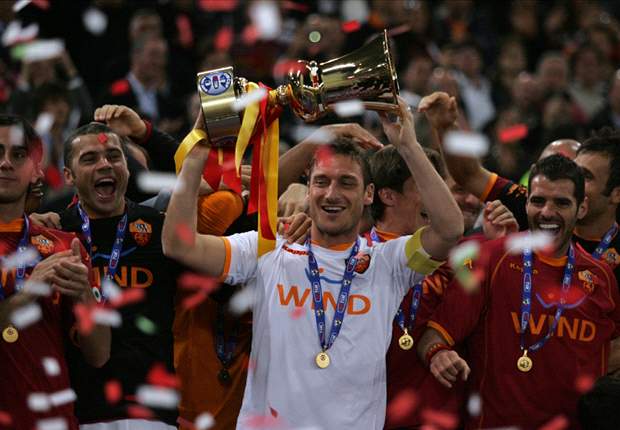
Roma were able to add another cup to their collection in 1972, with a 3–1 victory over Blackpool in the Anglo-Italian Cup. During much of the 1970s, Roma's appearance in the top half of Serie A was sporadic. The best place the club were able to achieve during the decade was third in 1974–75. Notable players who turned out for the club during this period included midfielders Giancarlo De Sisti and Francesco Rocca. The dawning of a newly successful era in Roma's footballing history was brought in with another Coppa Italia victory, they defeated Torino on penalties to win the 1979–80 edition. Roma would reach heights in the league which they had not touched since the 1940s by narrowly and controversially finishing as runners-up to Juventus in 1980–81. Former Milan player Nils Liedholm was the manager at the time, with players such as Bruno Conti, Agostino Di Bartolomei, Roberto Pruzzo and Falcão.
The second Scudetto did not elude Roma for much longer. In 1982–83, the Roman club won the title for the first time in 41 years, amidst celebrations in the capital. The following season, Roma finished as runners-up in Italy and collected a Coppa Italia title, they also finished as runners-up in the European Cup final of 1984.The European Cup final with Liverpool ended in a 1–1 draw with a goal from Pruzzo, but Roma eventually lost in the penalty shoot-out.Roma's successful run in the 1980s would finish with a runners-up spot in 1985–86 and a Coppa Italia victory, beating out Sampdoria 3–2.
After, a comparative decline began in the league, one of the few league highs from the following period being a third-place finish in 1987–88. At the start of the 1990s, the club was involved in an all-Italian UEFA Cup final, where they lost 2–1 to Internazionale in 1991.The same season, the club won its seventh Coppa Italia and ended runners-up to Sampdoria in the Supercoppa Italiana. Aside from finishing runners-up to Torino in a Coppa Italia final, the rest of the decade was largely sub-par in the history of Roma, particularly in the league, where the highest they could manage was fourth in 1997–98. The early 1990s also saw the emergence of homegrown striker Francesco Totti, who would go on to be an important member of the team and the club's iconic captain.
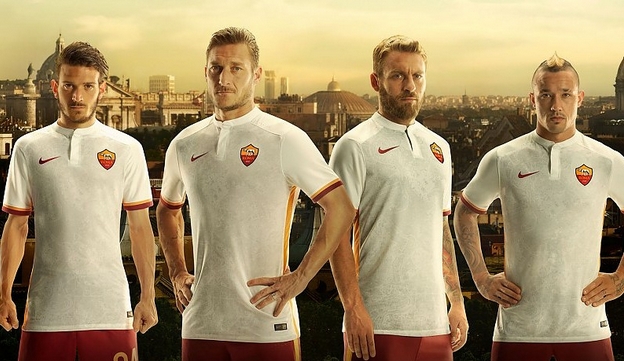
Roma's colours of imperial purple with a golden yellow trim represents the traditional colours of Rome, the official seal of the Comune di Roma features the same colours. The gold and the purple-red represent Roman imperial dignity. White shorts and black socks are usually worn with the red shirt, however in particularly high key matches, the shorts and socks are the same colour as the home shirt.
The kit itself was originally worn by Roman Football Club; one of the three clubs who merged to form the current incarnation in 1927. Because of the colours they wear, Roma are often nicknamed i giallorossi meaning the yellow-reds. Roma's away kit is traditionally white, with a third kit changing colour from time to time.
A popular nickname for the club is "i lupi" ("the wolves") –the animal has always featured on the club's badge in different forms throughout their history. The emblem of the team is currently the one which was used when the club was first founded. It portrays the female wolf with the two infant brothers Romulus and Remus, illustrating the myth of the founding of Rome, superimposed on a bipartite golden yellow over maroon red shield.In the myth from which the club takes their nickname and logo, the twins (sons of Mars and Rhea Silvia) are thrown into the River Tiber by their uncle Amulius. A she-wolf then saved the twins and looked after them. Eventually, the two twins took revenge on Amulius before falling-out themselves – Romulus killed Remus and was thus made king of a new city named in his honour, Rome.
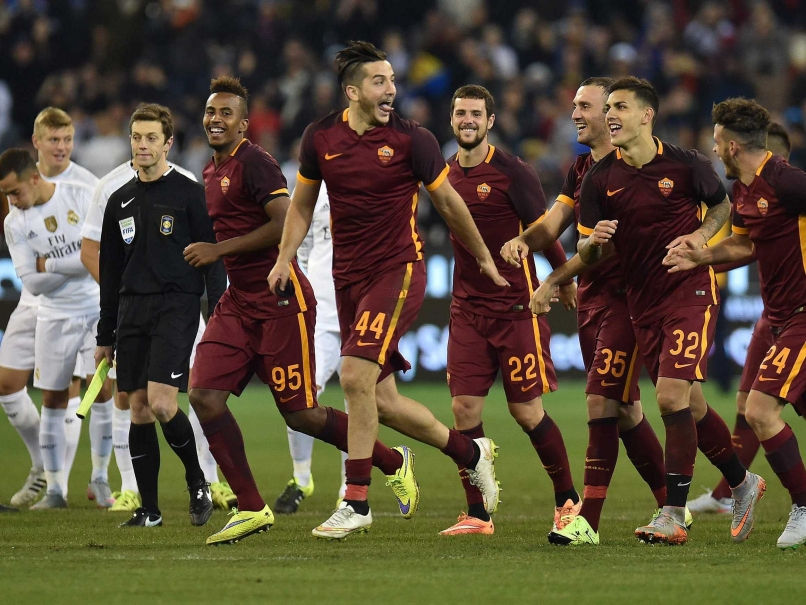
In the summer of 2010, the Sensi family agreed to relinquish their control of Roma as part of a debt-settlement agreement. This brought an end to the presidential reign of the Sensi family, who had presided over the club since 1993. Until a new owner was appointed, Rosella Sensi would continue her directorial role of the club. The 2010–11 season had once again seen Roma start off with mixed fortunes on both a domestic and European level. These included losses against Cagliari, Brescia and a 2–0 defeat against Bayern Munich in the group stages of the Champions League, a match which saw manager Claudio Ranieri openly criticised by his players. However, these were accompanied by victories against Inter and a sensational victory against Bayern Munich in the return fixture, which saw Roma fight back from 0–2 down at half-time to emerge as 3–2 winners. Following a series of poor results which saw Roma engage in a winless-streak of five consecutive matches, Ranieri resigned as head coach in February 2011, and former striker Vincenzo Montella was appointed as caretaker manager until the end of the season. It was also during this season that Roma icon Francesco Totti scored his 200th Serie A goal against Fiorentina in March 2011, becoming only the sixth ever player to achieve such a feat.
On 16 April 2011, the takeover contract was closed with an American investment group led by Thomas R. DiBenedetto, with James Pallotta, Michael Ruane and Richard D'Amore as partners. DiBenedetto became the 22nd president of the club, serving from 27 September 2011 to 27 August 2012 and was succeeded by Pallotta. The new intermediate holding company, NEEP Roma Holding, was 60% owned by American's "AS Roma SPV, LLC" and the rest (40%) was retained by the creditor of Sensi, UniCredit. In turn, NEEP owned all shares held previously by Sensi (about 67%) with the rest free float in the stock market. UniCredit later disinvested NEEP Roma Holding to sell to "AS Roma SPV, LLC" and Pallotta.
The new ownership immediately went into effect by making significant changes in the club, hiring Walter Sabatini as director of football and former Spanish international and Barcelona B coach Luis Enrique as manager. The first high-profile player signings from the duo were attacking midfielder Érik Lamela from River Plate, forward Bojan from Barcelona, goalkeeper Maarten Stekelenburg from Ajax and unattached defender Gabriel Heinze. The club also sold and released defender John Arne Riise, goalkeeper Doni and forwards Jérémy Ménez and Mirko Vučinić. At the financial level, the company had recapitalised for more than €100 million, the last recapitalisation occurring in the early 2000s.
Roma, however, was eliminated from 2011–12 UEFA Europa League play-off round. After the formal takeover on 18 August, Roma bought forward Dani Osvaldo, midfielders Miralem Pjanić and Fernando Gago and defender Simon Kjær, as well as youngster Fabio Borini, which cost the club more than €40 million. In 2012, Pallotta became the new president.

The 2012–13 pre-season started with the June hiring of former manager Zdeněk Zeman. Zeman replaced Luis Enrique who resigned at the end of the 2011–12 season. Luis Enrique's lone season reign had seen the disappointing loss to Slovan Bratislava in the UEFA Europa League, as well as the inability to qualify for international competitions for the 2012–13 season. Roma eventually finished seventh, losing the Europa League chase to rivals Lazio, Napoli and Internazionale. Zeman brought back his high-scoring 4–3–3 formation and his hard working ethic which successfully guided former team Pescara to the Serie A. However, he was sacked on 2 February 2013. He was replaced by caretaker manager Aurelio Andreazzoli, whose reign saw the continuation of a disappointing season, with the team ending up in sixth place in Serie A, while also losing 1–0 to rivals Lazio in the Coppa Italia final. As a result, Roma missed out on European competition for the second-straight season.
On 12 June 2013, Pallotta announced that Rudi García had been appointed the new manager of Roma. He enjoyed a fantastic start to his Roma career, winning his first ten matches (an all-time Serie A record) including a 2–0 derby win against Lazio, a 0–3 victory away to Internazionale and a 2–0 home win over title rivals Napoli. During this run, Roma scored 24 times while conceding just once, away to Parma. The 2013–14 season saw one of Roma's best ever in Serie A, the club tallying an impressive 85 points and finishing second to Juventus, who won the league with a record-breaking 102 points. Roma's defence was significantly better than in previous seasons, with only 25 goals conceded and a total of 21 clean sheets, including nine in their first ten matches.
In 2014–15, Roma finished second behind Juventus for the second consecutive season after a poor run of form in 2015. At the end of season the club was sanctioned for loss making and breaking UEFA Financial Fair Play Regulations.On 13 January 2016, García was sacked after a run of one win in seven Serie A matches. Luciano Spalletti was subsequently appointed manager of Roma for his second spell. On 21 February, Totti publicly criticised Spalletti due to his own lack of playing-time since returning from injury. Consequently, Totti was subsequently dropped by Spalletti for Roma's 5–0 win over Palermo, with the decision causing an uproar among the fans and in the media. After their initial disagreements, Spalletti began to use Totti as an immediate impact substitute, which proved to be an effective decision, as the Roma number 10 rediscovered his form and contributed with four goals and one assist after coming off the bench in five consecutive Serie A matches.As a result, Spalletti was able to lead Roma from a mid-table spot to a third-place finish in Serie A, clinching the UEFA Champions League play-off spot.During the summer of 2016, Roma lost star midfielder Miralem Pjanić to rivals Juventus to improve its financial position. On 13 June 2017, Eusebio Di Francesco was appointed as Roma manager, replacing Spalletti, who left for Internazionale.
Roma is the fifth-most supported football club in Italy – behind Juventus, Internazionale, Milan and Napoli – with approximately 7% of Italian football fans supporting the club, according to the Doxa Institute-L'Espresso's research of April 2006. Historically, the largest section of Roma supporters in the city of Rome have come from the inner-city, especially Testaccio.
The traditional ultras group of the club was Commando Ultrà Curva Sud commonly abbreviated as CUCS. This group was founded by the merger of many smaller groups and was considered one of the most historic in the history of European football. However, by the mid-1990s, CUCS had been usurped by rival factions and ultimately broke up. Since that time, the Curva Sud of the Stadio Olimpico has been controlled by more right-wing groups, including A.S. Roma Ultras, Boys and Giovinezza, among others. However, the oldest group, Fedayn, is apolitical, and politics is not the main identity of Roma, just a part of their overall identity. Besides ultras groups, it is believed Roma fans support the left as opposed to Lazio supporters, which are notoriously proud of their right-wing affiliation. In September 2009, the club unveiled plans to build a new 55,000-capacity stadium in Rome's western suburbs.
In November 2015, Roma's ultras and their Lazio counterparts boycotted Roma's 1–0 victory in the Derby della Capitale in protest at new safety measures imposed at the Stadio Olimpico. The measures – imposed by Rome's prefect, Franco Gabrielli – had involved plastic glass dividing walls being installed in both the Curva Sud and Curva Nord, splitting the sections behind each goal in two. Both sets of ultras continued their protests for the rest of the season, including during Roma's 4–1 victory in the return fixture. Lazio's ultras returned to the Curva Nord for Roma's 1–4 victory in December 2016, but the Roma ultras continue to boycott matches.
The most known club anthem is "Roma (non-si discute, si ama)", also known as "Roma Roma",by singer Antonello Venditti. The title roughly means, "Roma is not to be questioned, it is to be loved," and it is sung before each match. The song "Grazie Roma", by the same singer, is played at the end of victorious home matches. Recently, the main riff of The White Stripes' song "Seven Nation Army" has also become widely popular at matches.
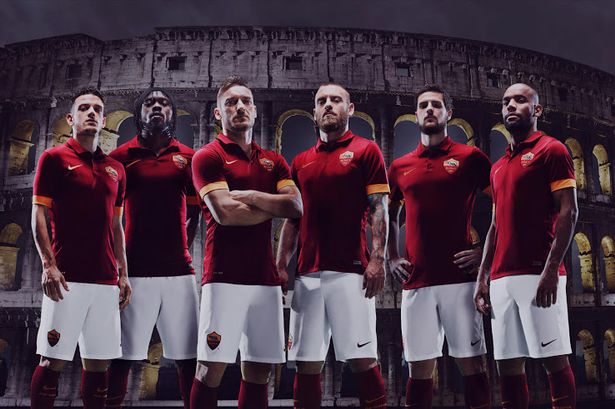
In Italian football, Roma is a club with many rivalries; first and foremost is their rivalry with Lazio, the club with whom they share the Stadio Olimpico. The derby between the two is called the Derby della Capitale, it is amongst the most heated and emotional footballing rivalries in the world. The fixture has seen some occasional instances of violence in the past, including the death of Lazio fan Vincenzo Paparelli in 1979–80 as a result of an emergency flare fired from the Curva Sud, and the abandonment of a match in March 2004 following unfounded rumours of a fatality which led to violence outside the stadium.
Against Napoli, Roma also compete in the Derby del Sole, meaning the "Derby of the Sun". Nowadays, fans also consider other Serie A giants like Juventus (a rivalry born especially in the 1980s), Milan and Internazionale (increased in recent years) among their rivals, as these four compete for the top three spots in the league table to secure a spot in the UEFA Champions League.
There have been a number of instances of conflict in recent years between some Roma supporters and fans of English clubs, and the subsequent violence outside the stadium which saw a number of Liverpool fans stabbed.Since then, there have been further instances of some English supporters being attacked and stabbed in Rome, including incidents in 2001 when Liverpool visited Roma twice and subsequent clashes with Middlesbrough fans in 2006 and Manchester United fans in 2007. In March 2009, a coach carrying Arsenal supporters was attacked by a group of Roma ultras just outside the Stadio Olimpico. The coach's windows were smashed and at least one person entered the vehicle, letting off a flare and stabbed a supporter in the knee.
Read More about soccer news, transfers, fixes via Sbobet-Mobile App